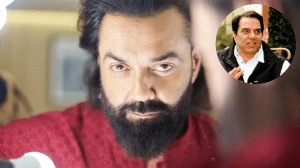The Environment Ministry does not have measurable standards. So how do you know what and whom to deal with?
Ajit Gulabchand,chairman and managing director of HCC,the company that is executing the project,speaks of the norms that the project allegedly flouted.
Ajit Gulabchand: HCC is the largest heavy civil engineering construction company,the second in the rural construction space. Weve built 25 per cent of Indias hydel power capacity,60 per cent of its nuclear powerreactors,10 per cent of its new national highway programme. We are the largest tunnelling contractor in Asia and now operate in Europe through a company we acquired called Karl Steiner AG–Switzerlands largest buildingconstruction company–which gives us access to the construction market fordoing buildings–green and high-rise buildings. We also have the distinction of taking on a city development project like Lavasa. This is a grand project in response to the Maharashtra government wanting to build a hill station city near Pune. It actually looks at the needs of Indias urbanisation–an estimated 400 million people will move to urban centres in the next 30-40 years. So,we really need to consider our urbanisation needs and this project couldnt have come at a better time to create a kind of replicable model of a new city. The speed with which we will have to build these urban centres or enhance existing ones would need some kind of public-private partnership. And Lavasa is a model,an experiment in making that happen. But we have to ask ourselves: How are we going to do this? because it is going to affect our environment. If we are allowed to do what we like,the development that India will have to do will create its own environmental problems. So how do we build new cities,create vibrant urban centres that also enhance the ecology in which they sit,not just restore it? Lavasa is attempting to create an idea that you can build such a city,build it rapidly,and not only restore or preserve the ecology but enhance it as well. For this we have been able to engage with experts around the world,including the most famous one Janine Benyus,who is the founder of the Biomimicry Guild. Just planting trees is not what gives you an ecology,how do you make it sustainable? The idea now is to create a social and an economic,as well as an environmentally enhanced entity which is sustainable. This is the challenge of creating cities and Lavasa is one attempt to do that. We are also into real estate. We built Indias largest stand-alone green building–247 Park over 1.8 million square feet. We have also moved from being simply a construction company to a large company that is looking to develop,build and operate both infrastructure and urban space. The engineering construction needs of this country are enormous. If you look at the infrastructure this country has to build,it is mind-boggling. When the Prime Minister announced that in the next Plan we would have $1 trillion investment in infrastructure,it sounded huge. But,it is not. Wed easily reach that figure. We were going to spend $500 billion during this Plan. We have a challenge of how do we create capacity to build that kind of infrastructure in such a short time. We also have the task of creating 300,000 new jobs in the next 20 years. We still have to create many rules of the game in which we will operate,and these are going to pose challenges too. We have to create new institutions,we have to strengthen existing ones. For example,to build all this we will need not just a good equity market,but a debt market,and we dont have a debt market. Well have to create new institutions if we have to raise debt to finance infrastructure. Infrastructure cannot be financed purely by equity. We need a bond market. With a bond market we need a credit default instrument. HCC is the only construction company that has a company-wide ERP (enterprise resource planning) for managing its projects. All its projects are connected in real time,including the highest place in the world where a hydroelectric project is being built at Nimoo-Bazgo (Ladakh),11,000 feet above sea level.
Coomi Kapoor: Can we talk about Lavasa specifically?
Ajit Gulabchand: As far as were concerned,this is a very proud project for us. Yes,it appears like there are many controversies just now. Some of them exist and some of them are inflated because the media likes to talk about them and therefore,you get a sense of them being bigger than they are. We have challenges,sometimes more than we can handle as we are just now facing. But nevertheless,we have a serious commitment to what we are to do.
P Vaidyanathan Iyer: How far do you think the stakes that Supriya Sule and Sadanand Sule held originally in the project affected it in terms of the attention it brought to the project?
Ajit Gulabchand: Lets first understand that Sadanand Sule,son-in-law of Sharad Pawar,had a stake in this project five or six years ago. Weve been working on this project for 10 years,its only since last year that we started some return on it. Sule is not just the son-in-law of Sharad Pawar,hes also the son of Balchandra Sule who was the former managing director of Mahindra & Mahindra. Hes also the nephew of BG Deshmukh,the former cabinet secretary of India. Balchandra Sule has been on my board for a long time,his son (Sadanand) too. Sharad Pawar’s association with the project essentially came after he was in England during the 80s and saw Lake District there. He felt that we too have four or five lakes created for irrigation and water–why couldn’t we use those to build something? So the idea was floated. But the idea was never concretised till the BJP government came to power–it is they who created the Hill Station policy. This is how it happened. There is a possibility,given the present cynical atmosphere,that Pawar’s association,his son-in-laws,might have drawn more attention to the project. Weve taken long to get our permissions,weve had long stints of trying to convince people because its a project that was never done before. We have a huge amount of archaic laws and some of them needed to be put into a new system of doing things–due processes have to be created. So,it has taken some time. The Maharashtra government wanted this built,it demarcated areas to build this,so it has a stake in it,to support and help such a project. Over the next 10 years,Lavasa will attract and will have an investment of Rs 40,000 crore. So,I think this project is unique. And,therefore,it already has its share of attraction,yes.
P Vaidyanathan Iyer: Recently,you met the Prime Minister. Was there any assurance by the Prime Minister on the project?
Ajit Gulabchand: In order to understand why I met the Prime Minister,we need to understand what happened to us. When we started this project,we took environment clearance from the government of Maharashtra. In fact,the Hill Station Act and policy of the government of Maharashtra actually lays down norms for the environment to be implemented. In addition to that,we had NEERI,the National Environmental Engineering Research Institute,to do an environment impact assessment. Based on that,mitigation factors were decided and on this basis we began work. In 2006,the Ministry of Environment and Forests of the Central government created a new notification. That notification said,Any area development of 50 hectares and more will have to come to the Central government. Prior to that there is a notification of 1994. It states that this is a state subject. Tourism projects created under the Hill Station Act are exempt,whether they are state or central. They added two more clauses in 2004. We did not think they applied to us because we had done all that is environmentally required. Had I known this was going to happen,I would have said,Even if you dont need,take it. According to the 2006 notification,every industrial estate developed by any state,every SIDCO (Small Industries Development Corporation Limited)-type project,all these require the permission of the MoEF in order to go ahead. We were surprised when one fine day we got a notice. We answered by saying to the Maharashtra government–Look,they want to know this,we gave them the whole history of how this happened. Then we got a notice soon after we got our clearance from Sebi to do an IPO. That notice was given to one journalist. It was a show-cause notice. There is another clause in 2004 which said anything above 1,000 metres requires permission and so we were asked why we didnt take the Central governments permission. A third clause said,For any other violations you may have committed,please stop work and restore status quo ante. Which means what weve built for five years must be destroyed,all the roads must be uprooted,all the 800,000 trees we have planted must be cut. We had to rush to court,we got the stay on the status quo. The court allowed them to go ahead and have an interim hearing. When they did that,they had Medha Patkar and everyone join in,and they gave a list of generalities of environmental issues like air,water soil.
Coomi Kapoor: Do you feel youve been singled out compared to other projects with the same violations?
Ajit Gulabchand: Im not so sure Ive been singled out,but Im disturbed that the project has been going on for 10 years,it has clearances of the state government…Assuming that there was a requirement of going to the Central government,the least was that you should have had a hearing,an inspection of what weve done to the environment first. This is not about environment,this is about jurisdiction.
Sunil Jain: How much have you built so far?
Ajit Gulabchand: Less than 1,000 hectares. But the issue is they have to have objective,measurable standards for what is to be done. They have appointed a state-level committee which has visited the site. They have to give terms of reference for environmental impact,which is exactly what the Maharashtra government did. We had no reason to presume that there was a problem. Let us assume that,yes,we are wrong and we did have to take their permission. Thats not a crime if weve addressed their environmental issues. We should have been given a hearing.
Sunil Jain: Is there any sort of objective norm that says if you cut a thousand trees,you have to plant 2,000 of a different variety?
Ajit Gulabchand: No. The MoEF does not have laid-down objectives and measurable standards. We asked for the norms so that we could compare whether we had committed any violations. They did not give us any. So we gave our own norms which the state government hill station policy lays down,which the environment impact assessment study lays down,and the ones we have created for ourselves.
Coomi Kapoor: Isnt height a specific point?
Ajit Gulabchand: Height is not a standard,height is jurisdiction. MoEF says,Above 1,000 metres if you are constructing anything,please come to us’,provided it is more than Rs 5 crore. We have filed our total acreage with the government. We have said we have 46 hectares above 1,000 metres with one arch and that we are not going to build on it,and itll just remain. That structure does not constitute a violation of anything because its just an arch. So fundamentally,they claimed it only from the point of view of jurisdiction,not because its environmentally wrong.
Rakesh Sinha: Is it as frustrating dealing the bureaucracy now?
Ajit Gulabchand: To some extent this is a bit Kafkaesque. I would like to work with the MoEF to create replicable models for other townships. There are various new standards that can be created,and those have to be created because if you dont want a set of slums all round the country then well have to build standards. The problem is because there is nothing there,how do you know what to deal with,whom to deal with? Thats the problem. Now,I dont know what were going to do,there is no agenda,nothing. Not that they shouldnt ask,not that they shouldnt do these things. What we feel is environment is a very sensitive,wonderful issue. We must espouse it. And there are many other issues of environment–chemical factories,carbon footprints,etc that need to be addressed.
Coomi Kapoor: There is a feeling that a large number of political heavyweights from Maharashtra have bought property in Lavasa.
Ajit Gulabchand: No,I dont think so. We have a very clean and open system of CRM (customer relationship management). You apply,you get it and you move forward. Politicians tomorrow may have a place there–why not? But if you think theyve been given (properties) for any favours,no.
P Vaidyanathan Iyer: What about local resentment? Youre drawing water from a dam that will affect water availability for people in Pune. How far does this lead to an escalation of the issue?
Ajit Gulabchand: Pune gets 11 trillion cubic feet of water per day which makes it the highest consumption per capita of water in the world. Pune was supposed to recycle water and send it down to Indapur,which they havent. As far as Lavasa is concerned,it would require less that 1 per cent of the water that Pune gets. Secondly,the lake,Varasgaon,doesn’t not meet Pune’s water needs; its an irrigation lake. Under the law,10 per cent of water from the lake is the entitlement of the people of the villages in Lavasa. As for local support,all the 18 gram panchayats have signed a unanimous resolution to support Lavasa. Ninety per cent of the villagers have actually come out in support,written letters.
P Vaidyanathan Iyer: The clearances which Lavasa got was when Ajit Pawar,Sharad Pawars nephew,was a minister and the entity under his administrative purview gave the clearances. So could you have avoided,first,getting shareholders like the Sules…
Ajit Gulabchand: Why should I avoid it? This is an unfair question. How was I supposed to know what would happen in the future? This is immaterial. There are so many things wrong with this country,do we go forward or not? Indira Gandhiused to own shares in our holding company. So should HCC never have got a contract in this country?
Amitabh Sinha: With POSCO,Vedanta and now you,there seems to be an attempt to make an example of high-profile projects. Do you share that view?
Ajit Gulabchand: I dont share that view,but it has so happened. But to the extent to which the environment minister wants environment to be on everybody’s agenda,I couldnt agree with him more. If you look at the promotional videos of Lavasa,be it one year ago or five years,you will see we talk of inclusiveness as well as environment all the time. No government was dictating it to us. So we are on the same side,the question is how do we go about it?
Smita Aggarwal: You operate in the critical space of infrastructure. And lobbying is part of this corporate culture. So when do you think lobbying becomes a dirty word?
Ajit Gulabchand: I have a right to lobby for my cause. Just as I have a right to lobby,I have a right to deploy the best to lobby for me. So there is nothing wrong with outsourcing lobbying. The question is,what does the lobbying do? As in all cases,there are Laxman rekhas. I am not prescribing one right now,but when it gets crossed,it becomes a problem. At the same time,those who are in public office need to know when its crossed. Why is the onus only on the (one) lobbying?
Sunil Jain: With all projects above 50 hectares having to be cleared by the MoEF,are you rethinking some of your projects like,say,Dhulera (Gujarat)?
Ajit Gulabchand: If you ask me whether I wake up in the morning asking,When am I going to add Dhulera? When am I going to do this?,my answer is not in the last one month,no. But I think,if this (Lavasa issue) is over,I will. Listen,just to do this you need to be an optimist.
P Vaidyanathan Iyer: Tell us about your meeting with the PM.
Ajit Gulabchand: The PM said he would look into this matter and that he would like to solve this issue. He understood the importance of what we are doing,he understood that such things would be needed.
P Vaidyanathan Iyer: In the interim,did you get in touch with the minister,Jairam Ramesh?
Ajit Gulabchand: The last time I tried to contact him,he did not allow me to reach him.
Ambreen Khan: Whats your take on the corruption thats happening nowadays?
Ajit Gulabchand: I avoid trying to be moralistic about these issues. If we can create more transparent systems,lay down rules of business and engagement,you are likely to get a far less corrupt society. Corruption has one downside that it causes you to lose the publics trust. And a whole lot has to be done to restore it.
P Vaidyanathan Iyer:What have been your losses now at Lavasa?
Ajit Gulabchand: Were losing Rs 2 crore a day. The stop work order has been implemented. Construction work is on hold. Of the 10,000 workers there,9,000 have been asked to go home and theyve gone.
Sunil Jain: Is it your understanding that the amount of work going on in the NHAI (National Highways Authority of India) is actually declining? Do you think its becoming more difficult to work there?
Ajit Gulabchand: When NHAI began,they (government) laid down some very brilliant processes. They also came up with a really new idea that you can work on a public-private partnership basis. But the fact is that there are problems in our country. And there is a cynical atmosphere even among the decision makers. Today,since most of the NHAI programme is dependent on actual private investment coming into roads,you are going to have a problem. The investment climate needs to improve. In India,the fundamentals are weakening and so is sentiment. Ive gone around the world saying,invest in India,its an emerging market so it will have some problems. Now,what will I tell them? Im already feeling guilty that on my assurance peoplehave invested,even in Lavasa.
Vaidyanathan Iyer: You were talking about investors raising questions. Do you think this year India will have a tough time at Davos (World EconomicForum)?
Ajit Gulabchand: I have a different speech…Ill say youll have to have double theoptimism to invest in India. But I am hoping that this is an aberration andthat with all that has happened,the intention was not really to block andthat things will fall into place.
Transcribed by Sanjeev Menon
For the longer version,visit http://www.indianexpress.com
- 01
- 02
- 03
- 04
- 05































